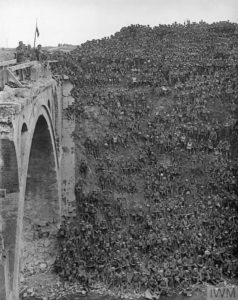Tuesday October 1st, 1918
On the move again. Combles
Moving again
The 9th Battalion is continuing to move towards the front lines. According to the War Diary, they are now under the command of the XIII Corps, which is the Reserve Corps of the Fourth Army.
A coordinated, consolidated attack, known as the Grand Offensive, was launched by the Allies just a few days ago and will lead to the end of the War. As the 9th will soon be engaged in it, it seems appropriate to provide some more details here.
The Grand Offensive
Planned by Marshall Foch, the Grand Offensive’s objective was to advance the entire front line – from Ypres in Belgium to the Argonne Forest near Verdun. Over 100 kms of this comprised the, to-date impregnable, Hindenburg Line. The attacks comprised:
Meuse-Argonne Offensive launched on September 26th by the French and American Expeditionary Force (AEF). To the south of the Hindenburg Line, it will include the Battles of Somme-Py, Saint-Thierry, Montfaucon, and Chesne. The Offensive will continue until the end of the War, during which time the Allies will advance more than 20 miles. Over 1.2 million AEF troops were involved and it was their costliest engagement in WWI with over 26,000 casualties.²
The Fifth Battle of Ypres (September 28th – October 2nd) was fought by the Belgian Army, the British Second Army and the French Sixth Army. The Allies advanced 18 miles before being literally bogged down. However they will soon resume the offensive with the Battle of Courtrai (October 14th – 22nd) during which they reach the Dutch border and the River Scheldt. By Armistice they will have advanced 45 miles and join up with the Allies on the Somme.

Various attacks on the central Hindenburg Line commenced on September 29th, with the British Fourth Army (comprising British, Australian and American forces) at the Battle of St Quentin Canal and the French First Army attacking fortifications outside the city.
The photographs shows Brigadier-General Campbell VC addressing men of the 137th Brigade of the 46th Division. They are on the Riqueval Bridge which crosses the St Quentin Canal.* Some men of the 1/6th Battalion, the North Staffordshire Regiment had managed to seize the bridge over the canal before the Germans had a chance to blow it up.³
‘The assault across the canal met all of its objectives, on schedule, at a cost of somewhat fewer than 800 casualties to the division. The great success of the day had come where many had least expected it. The 46th Division assault was considered to be one of the outstanding feats of arms of the war.‘³
By 5 October, the Allies will break through the entire depth of the Hindenburg defences over a 19 mile front.
On 8 October, the First, Third and Fourth British Armies will again break through the Hindenburg Line at the Second Battle of Cambrai. Through October they will push the Germans from lands they had held since 1914.
Consequences
In all these battles, the Allies proved victorious. While they would go onto face fierce rearguard actions from the Germans until the Armistice:
‘This collapse forced the German High Command to accept that the war had to be ended. The evidence of failing German morale also convinced many Allied commanders and political leaders that the war could be ended in 1918; previously, all efforts had been concentrated on building up forces to mount a decisive attack in 1919.‘¹
9th Battalion War Diary – 1st October 1918 – Proyart
Ref Maps – France Amiens 1, Valenciennes 12, St Quentin 18
Battalion marched to Maricourt and billeted in old tin sheds. The 66th Division is now in the Fourth Army and 13th Corps. Captain FO Thorne MC having joined the Battalion is taken on strength and posted to C Coy.
References & Further Reading
¹ Hundred Days Offensive on Wikipedia
² Meuse-Argonne Offensive on Wikipedia
³ Battle of St Quentin Canal on Wikipedia
* Q 9534, copyright Imperial War Museums


